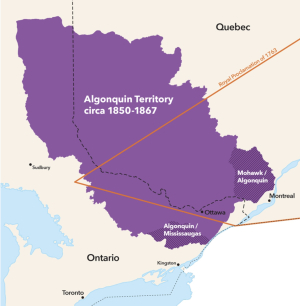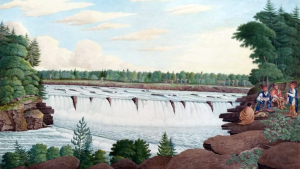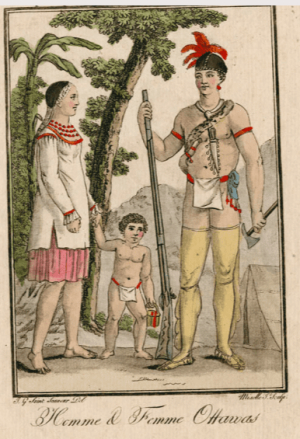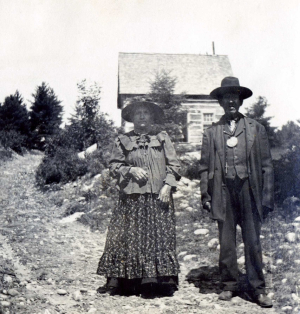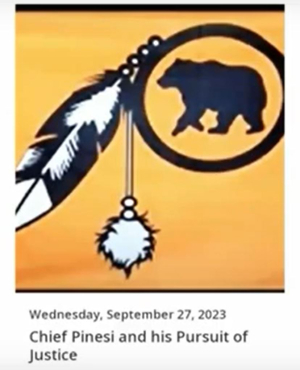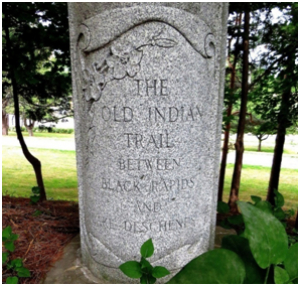Peter Di Gangi – Algonquin Territory – Indigenous Title Yet Resolved
Peter Di Gangi, based in Ottawa, is an established expert on Indigenous historical, legal and cultural research, working with Indigenous communities for over 40 years.
Peter points out that the traditional territory of the Algonquin people has always included the Ottawa Valley and adjacent lands, straddling the border between what is now Quebec and Ontario, but unlike most of Ontario and the Prairies, Algonquin territory has never been dealt with by a land-sharing Treaty and Algonquin title continues to exist.
This article was published in Canada’s History: www.canadashistory.ca/explore/politics-law/algonquin-territory
Lynn Gehl – Akikodjiwan
Lynn Gehl, PhD, author, activist and member of the Algonquins of Pikwàkanagàn First Nation, makes the case, in this 2018 article, that historic and current development has betrayed the "Asinabka" vision of the late Chief William Commanda and desecrates what should alternatively be preserved and honoured as our nation's potential "heart of reconciliation":
The Chaudière Falls (Akikodjiwan) and surrounding landscape have long been a sacred place for Algonquin and other First Nations. How has this been impacted over the past two centuries, since the arrival of Europeans in the Ottawa area?
Has the historic and ongoing development of the Chaudière district (Chaudière Falls and Chaudiére, Albert, and Victoria Islands) been emblematic of our nation's disregard for Indigenous rights and jurisdiction?
Akikodjiwan - The Destruction of Canada’s Heart of Reconciliation
Prior to colonization, the Algonquin Anishinaabeg relied on the land and waterways now known as the provinces of Ontario and Quebec and the Ottawa River. Through the gifts they provided, the Algonquin achieved mino-pimadiziwin (the good life).
It was through Nanaboozo’s hardship of living without a father, his process of seeking revenge and learning forgiveness, that human beings understand reconciliation. The Spirit of the West Wind gave the First Sacred Pipe to his son Nanaboozo, instructing him about the rituals of reconciliation that include ceremony and prayer as the practices of reunion between father and son, peoples, and nations.
“During the historic treaty process British officials ignored the Algonquin because our very territory was becoming the heart of Canada.”
While many people think this Nanaboozo story is a romantic belief that lacks rationality, it is much more. Sacred beliefs that value the natural world are far more sustainable and intelligent than the destruction that manifests through the current economic paradigm, resulting in the polluting of our land and waterways with such things as plastic, sewage, chemicals, and radioactive particles.
During the historic treaty process British officials ignored the Algonquin because our very territory was becoming the heart of Canada. Through subjugating the Algonquin, the colonizers were able to appropriate Algonquin territory and centralize their Parliament base.
Many people today think Canada is in a better place with Indigenous nations. This is not so. Through the power gained from pilfering Indigenous land and water rights, Canada continues to divide the Algonquin through practices such as obfuscating and spinning what Canada’s treaty responsibilities are.
“In a world of economic power that lacks an understanding of the importance of preserving what is sacred, Algonquin jurisdiction and human rights continue to be pushed aside.”
Akikodjiwan and Akikpautik (Pipe Bowl Falls), located in the Ottawa River just upstream from Canada’s Parliament, are the very land and waterscapes where Creator placed the First Sacred Pipe. Through colonization Akikpautik was eventually dammed, and the islands that make up the larger Akikodjiwan landscape are now called Chaudière, Albert, and Victoria Islands. It was Grandfather William Commanda’s vision to have this sacred place restored. His Asinabka plan was endorsed and promised by many.
Unfortunately, despite Prime Minister Justin Trudeau’s rhetoric of respecting a “nation-to-nation” relationship and calling for “reconciliation,” the current Liberal government is permitting the further desecration of this sacred place. I offer here a timeline of the continued destruction of the ultimate place of reconciliation inscribed by Creator.
1613: Samuel de Champlain records the Anishinaabeg offering tobacco to Akikpautik (Pipe Bowl Falls), also called Asticou meaning “the boiler.” Champlain translates this as “Chaudière.”
1806: Philemon Wright’s lumber industry begins within Algonquin traditional territory in the Ottawa River Valley.
1854: The Government of the Province of Canada approves an Order-in-Council reserving the Chaudière Islands and adjacent area of the Ontario shoreline for public purposes.
1856: Leases are issued so the lumber industry can harness the water’s energy for their sawmills. These lots are on Chaudière, Albert, and Victoria Islands.
1880: J.R. Booth now holds most of the lease interests on the Islands.
1908: A large ring dam is constructed extending from Chaudière Island over the entire span of the falls. Eventually E.B. Eddy takes over its operation for pulp and paper manufacturing purposes.
1913: William Commanda is born and becomes a respected knowledge holder and Grandfather. Eventually he has a vision about re-naturalizing Chaudière Falls and the Islands. He wants the sacredness of Akikpautik returned to its natural form and the islands housed with a park, an Indigenous centre, and a peace-building meeting site for all peoples. He calls his plan “Asinabka.”
1936: Prime Minister Mackenzie King commissions Jacques Gréber to create a master plan that will govern the development of the National Capital Region.6 It was completed in 1950. Gréber concludes the most effective improvement will be the central park at the Chaudière Falls.
1958: The National Capital Commission (NCC) is established to implement Gréber’s Master Plan.
1969: The NCC purchases 40 per cent of E.B. Eddy’s operations. As a condition the NCC gains first call on E.B. Eddy’s remaining property.
1990: Plans are announced regarding an Indigenous Centre on Victoria Island.
1998: Grandfather Commanda consults with the NCC, Douglas Cardinal, Algonquin communities in the provinces of Ontario and Quebec, and Indigenous and non-Indigenous peoples regarding his Asinabka Plan.
Domtar purchases E.B. Eddy’s operations. This does not mean Domtar purchased the land and waterscape.
2003: Grandfather Commanda asks the NCC and Domtar to produce the deeds to the Islands; nothing materializes.
2004: The Ministry of Canadian Heritage grants Grandfather Commanda $50,000 to further conceptualize his Asinabka Plan.
2006: The NCC endorses Asinabka and allocates $35 million toward it.
Grandfather Commanda prophesizes, “It is a vision for the revitalization of this Sacred Site, Asinabka, at the circular Chaudière Rapids, Akikpautik: The Pipe Bowl Falls.”
Stephen Harper is elected as prime minister and opens the doors for corporate development in respect to the Islands.
2007: Domtar closes their paper mill operation.
2010: The City of Ottawa endorses Grandfather Commanda’s Asinabka Plan.
2011: With great sadness, Grandfather Commanda passes into the spirit world.
2012: Domtar places their interests up for sale. The NCC applies for funds but the treasury board refuses.
Canada permits the transfer of the Ring Dam to Energy Ottawa, a municipally owned power company.
2013: Windmill Development Group publicly announces interest in the Islands, discussing the need for re-zoning for their condominium and commercial development project.
2014: The Circle of All Nations reports that the Service Ontario Land Registry indicates Chaudière Island is not owned by Domtar.
Ottawa City council votes in favour of Windmill’s application to re-zone the islands from “parks and open space” to “downtown mixed use.”
Kitigan Zibi First Nation releases a statement: “Our traditional territory has always been and continues to be, Unceded. We hereby put Canada, Québec and Ontario on notice that [the] status quo, in which our Aboriginal title lands are taken up by governments and industry, is not acceptable.”
Douglas Cardinal, Romola V. Thumbadoo-Trebilcock, Richard Jackman, Larry McDermott, and Lindsay Lambert file an appeal to the Ontario Municipal Board (OMB) regarding the re-zoning.
2015: Windmill re-names their project as “Zibi.”21 Chief Gilbert Whiteduck argues the use of the Algonquin word is cultural appropriation.
May 2015: The City of Ottawa files a motion requesting the OMB dismiss the five appeals regarding the re-zoning due to a lack of planning grounds. This would result in the denial of a full hearing.
June 2015: The OMB pre-hearing begins with member Richard Makuch presiding.
August 2015: The Ottawa Citizen reports that Domtar sells their operations to Windmill. This involves land that Domtar has never proven they own.23 The Service Ontario Land Registry identifies Windmill as leasing the land from Domtar.
The OMB pre-hearing resumes. The appellants argue consultation is required, and that the re-zoning was a departure from the Gréber and Asinabka Plans.
The City and Windmill argue the appellants lack planning grounds, Chaudière Island is no longer an Indigenous cultural site of significance because of the industrial era, and all the land is in private hands. Wolf Lake, Timiskaming, Eagle Village, and Barriere Lake First Nations call for the protection of Akikodjiwan.
November 2015: Makuch dismisses the five appeals on the grounds that the re-zoning conforms to the City’s plan, the appellants failed to raise legitimate planning grounds. He also argues there was adequate consultation with Pikwàkanagàn First Nation and the organization known as the Algonquins of Ontario. In this way he imposes colonial provincial borders on the process of justice thus denying the rights of the larger Algonquin Nation that spans the Ottawa River and includes the Algonquin located in Quebec, both status and non-status Algonquin.
Justin Trudeau is sworn in as prime minister claiming to respect the “nation-to-nation relationship” and genuine “reconciliation.”
The Assembly of the First Nations of Québec and Labrador pass a resolution to protect Akikodjiwan.
Despite Algonquin and settler opposition, Energy Ottawa begins drilling a water channel deep into the bedrock of Chaudière Island27 for additional hydroelectric generation.
March 2016: The appellants appear in the Ontario Divisional Court (ODC) seeking leave to appeal the OMB decision. Justice Charles T. Hackland dismisses them on the grounds the OMB made no errors of law.
June 2016: In protest, more than five hundred people, both settler and Indigenous, walk from Victoria Island to Parliament Hill.
October 2016: Appellants appeal again to the ODC regarding Hackland’s dismissal. A panel of three judges denies the appellants.
December 2017: Although it is said the Tsilhoqot’in decision ushered in a new paradigm regarding Indigenous rights of consent versus consultations, on December 15, 2017, the Government of Canada approved a series of land transfers between the National Capital Commission, Public Services and Procurement Canada, the Ontario Ministry of Natural Resources and Forestry, and Windmill Dream Zibi for lands on islands in the Ottawa River. This happened without the consent of the larger Algonquin Nation, which includes the status and the non-status in both Quebec and Ontario.
February 2018: As of February 5th, 2018 the Service Ontario Land Registry assigns Windmill Dream Zibi Ontario Inc. parcels of land on Chaudière Island and Albert Island.
Contrary to what the City of Ottawa, Windmill Development, and the Ontario Municipal Board argued, the appellants rested their arguments on legitimate planning grounds: Jacques Gréber’s Master Plan and Grandfather William Commanda’s Asinabka Plan.
Both plans long pre-dated Windmill’s project, yet in a world of economic power that lacks an understanding of the importance of preserving what is sacred, Algonquin jurisdiction and human rights continue to be pushed aside. Clearly the Liberal government’s rhetoric of respecting a nation-to-nation relationship and seeking genuine reconciliation is a bold-faced lie.
Author Lynn Gehl © 2018, Lynn Gehl Ph.D. All rights reserved.
(Published in the Watershed Sentinel)
Reprinted with permission of the author.
Lynn Gehl, PhD., is a member of Pikwàkanagàn First Nation. She is the author of two books: 2014’s The Truth That Wampum Tells: My Debwewin on the Algonquin Land Claims Process with Fernwood Publishing; and 2017’s Claiming Anishinaabe: Decolonizing the Human Spirit with the University of Regina Press.
Here is a link to the full article: https://watershedsentinel.ca/articles/akikodjiwan/
Follow this link to view more of Lynn Gehl's work: www.lynngehl.com
Dr. Gehl recommends these resources as further reading:
Matchewan, J-M. (1992, February 4). Algonquin Nation as Represented by Barriere Lake, Kipawa, Timiskaming and Wolf Lake. Retreived from https://publications.gc.ca/collections/collection_2018/aanc-inac/R5-648-1992-eng.pdf
Di Gangi, P. (2018, April 30). Algonquin Territory: Indigenous title to land in the Ottawa Valley is an issue that is yet to be resolved. Canada’s History. Retrieved from https://www.canadashistory.ca/explore/politics-law/algonquin-territory
Dumont, A. (South Wind). (2013, December 28). The Kettle of Boiling Waters: Chaudière Falls, Algonquin Territory. Albert Dumont.Retrieved from http://albertdumont.com/the-kettle-of-boiling-waters-chaudiere-falls-algonquin-territory/
Gehl, L. (2016, November 15). Deeply flawed process around Algonquin land claim agreement. Policy Options.Retrieved from https://policyoptions.irpp.org/magazines/november-2016/deeply-flawed-process-around-algonquin-land-claim-agreement/
Gehl, L. (2018b, March 8). Akikodjiwan: The Destruction of Canada’s Heart of Reconciliation. Watershed Sentinel. Retrieved from https://watershedsentinel.ca/articles/akikodjiwan/
Huitema, M.E. (2000). “Land of Which the Savages Stood in no Particular Need”: Dispossessing the Algonquins of South-Eastern Ontario of Their Lands, 1760-1930 . Master of Arts thesis, Queen’s University, Kingston, ON. Retrieved from https://iportal.usask.ca/record/6234
Jury, E.M. (1966). Tessouat (Besouat); Tessouat (Le Borgne de l’Île); Tessouat (Tesswehas, Le Borgne de l’Île) Paul. Dictionary of Canadian Biography (Vol. 1) (pp. 638-641). Toronto: University of Toronto Press. Here they are online.
- https://www.biographi.ca/en/bio/tessouat_1603_13_1E.html
- https://www.biographi.ca/en/bio/tessouat_1636_1E.html
- https://www.biographi.ca/en/bio/tessouat_1654_1E.html
Matchewan, N. (2008). Blockades: Algonquins of Barriere Lake Defend the Forest, 1989-2008. In First Nations Strategic Bulletin. Volume 6, Issue 1, September – October 2008. (pp. 28-29). Retrieved from https://epe.lac-bac.gc.ca/100/201/300/first_nations_strategic_bulletin/2008/v06n02.pdf
Pasternak, S. (2009, October 26). They’re Clear Cutting Our Way of Life: Algonquins Defend the Forest. Upping the Anti. Retrieved from https://uppingtheanti.org/journal/article/08-theyre-clear-cutting-our-way-of-life/
Pugliese, K. (2005). ‘So, where are you from?’ Glimpsing the history of Ottawa-Gatineau’s Urban Indian Communities. Master’s thesis, Carleton University, Ottawa, ON. Retrieved from https://repository.library.carleton.ca/concern/etds/0v838113m
Sarazin, G (1992). 220 Years of Broken Promises. In B. Richardson (Ed.), Drumbeat: anger and renewal in Indian country (pp. 167-200). Toronto: Summerhill Press. (original work published 1989)
Whiteduck, K. (2009). Our Majestic Forests: An Aboriginal View of Algonquin Park. In D. Euler & M. Wilton (Eds.), Algonquin Park: The Human Impact (pp. 36-54). Espanola, ON: OJ Graphix Inc.
http://www.asinabka.com/geninfo.htm
https://qshare.queensu.ca/Users01/gordond/planningcanadascapital/greber1950/
https://ricochet.media/en/101/ottawa-city-council-approves-rezoning-sacred-algonquin-site
http://rabble.ca/news/2016/06/condominium-development-threatens-protection-algonquin-sacred-site
James Powell – The Anishinabek
James Powell is the author of the blog Today in Ottawa's History giving a day-by-day account of local history.
The Anishinabek
For thousands of years before the Rideau Canal and Bytown, the Ottawa Valley was home to the Anishinaabe Algonquin people and remains their unceded land. James Powell explores the story of the Algonquin people and the devastating impact that European settlement had on their lives and livelihoods: The Anishinabek, Time Immemorial, 7 October 1783
Going Up the Dumoine
Part One: Pre-Logging
The Kichi Sipi, also known as the Ottawa River, is the thirteenth longest river in Canada. The rivers’ one hundred and forty-six thousand square miles watershed is bisected by the Sibi’s serpentine route as it curls back on itself going west from its source north of Ottawa, then heading southeast from Lake Témiscamingue to the St Lawrence River. It is the traditional unceded territory of the Anishinabe-Algonquin Nation. From the interior, sixteen major tributaries flow from various large headwater lakes to form multiple access routes into the watershed. The only major tributary to have never been dammed, settled, or industrialized save for logging, is the Dumoine. It is now protected as a Quebec aquatic reserve (2008) along with the Coulonge and Noire (2023).
The Kichi Sibi is the watershed that defined the Anishinabe-Algonquin history for time immemorial. Groups of Anishinabe families separately identified themselves as unified self-regulating custodians for ‘their tributary . ’ Together they all formed the Anishinabe-Algonquin Nation. Each family (10-20 related individuals) was assigned approximately a thousand square mile hunting territory, orally defined using natural feature boundaries, and protected by customary law. The Dumoine was a popular route for other nations to cross the Algonquin territory. The Dumoine families, of course, used it frequently to paddle to Algonquin rendezvous for social events. These events were centred on trade, religion, and customary law. The summer wanderings of the families were focused on seasonal harvesting of spawning fish and eels, birds migrating, maturing of fruit, vegetable and medicinal plants, and the gathering of raw materials. These materials were used for creating canoes, hunting and cooking tools, clothing, footwear, dwellings, baskets, and infant cradles. All these goods were often decorated with impressive artwork. The Dumoine group of families, known first to the Jesuits and Champlain as the Otaguottouemin, were identified two centuries later in government documents as the Dumoine Band. Their story is typical of those Algonquins that lived for centuries along the major tributaries.
Long before the Europeans arrived, the Dumoine Band maintained a lifestyle that involved wintering in their designated hunting territories while hunting and trapping. They used the paddling season for travelling throughout the watershed. The chiefs endorsed a few adventuresome individuals to participate in war or trade missions further afield. A wide variety of other First Nations traders brought goods to these families, most often at the trading site at the mouth of the Dumoine. These goods originated from the Mississippi watershed, the Great Lakes, the James Bay, and the Atlantic Ocean, so a variety of food, goods, and cultural ideas penetrated the interior long before the first white man arrived.
The mouth of Dumoine featured a long sandy spit that rose gracefully up into the pine forest as a grass-covered gravel bar capable of growing root crops. It formed a perfect camping and trading site. The Wolf Lake elders (2022), the direct descendants of the Dumoine families, shared with us the name Akonakwasi for this site meaning ‘a long stretch of sand extending far away’ adding Sakik for the mouth and Sibi for the river (now underwater since the Rapides des Joachims dam was built in 1950).
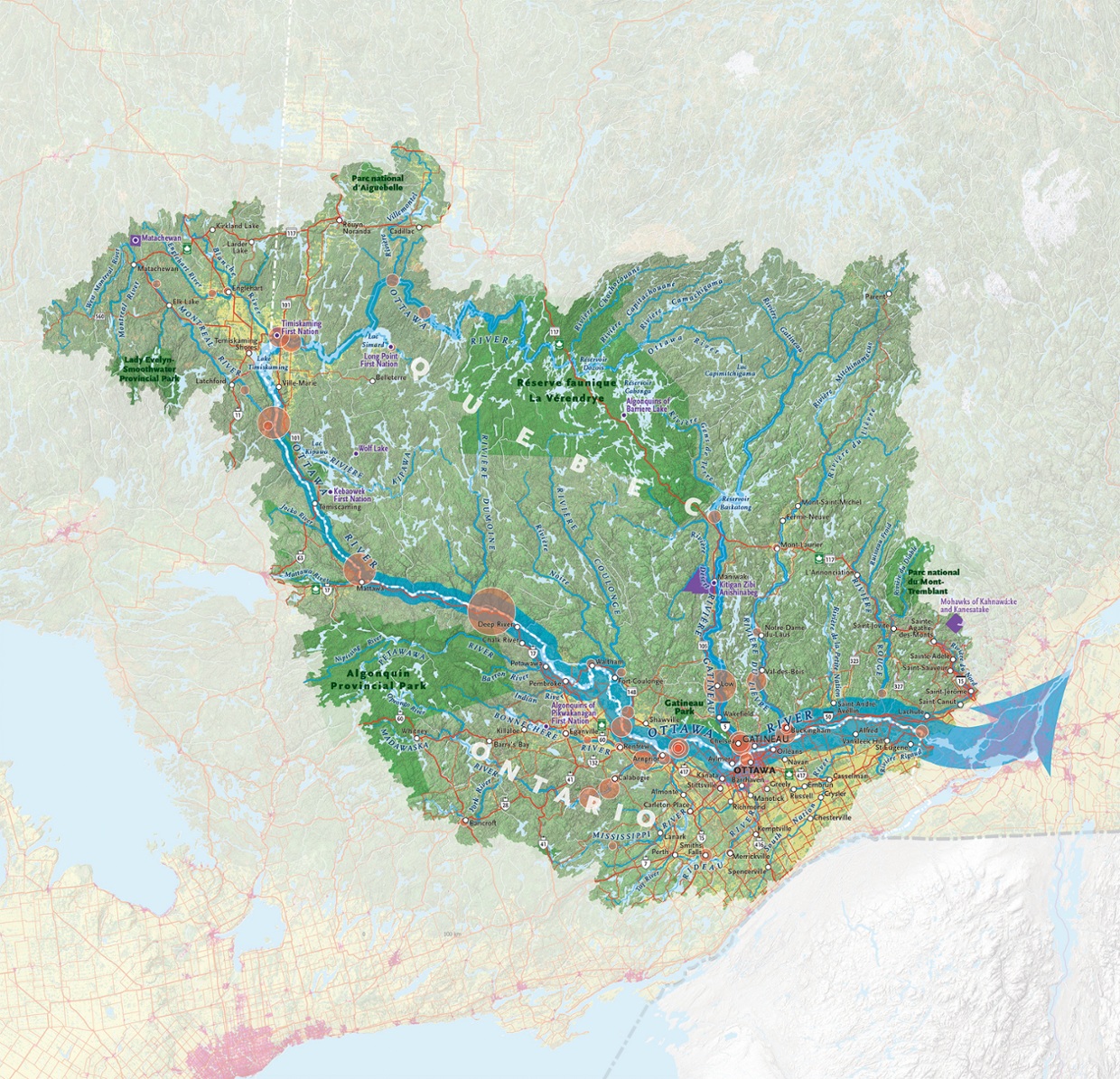 Canadian Geographic map of Ottawa River Watershed.
Canadian Geographic map of Ottawa River Watershed.
It is a challenging four day paddle up the Dumoine which rises one hundred vertical feet as falls, chutes and rapids from the mouth to Lac Dumoine. The creation of magnificent Lac Dumoine is as difficult to imagine being done by a retreating glacier, carving out this eighty-one square mile lake as it is to imagine Nenabojo (also known as Wiske’djak the Anishinabe trickster) chasing a giant beaver out of the south end churning up the land and forming the Dumoine River in the process. But both are accepted stories in different cultures. Lac Dumoine (Anishinabe name is Keewagama one of the many accepted spellings) is unique for four long outlets stretching in each cardinal direction and with a river entering or exiting each. It is a natural traffic circle and has served as an important crossroads for trade and travel since the melting glacier filled it.
French explorer, Samuel de Champlain, was one of the first white men to travel the Kichi Sibi in 1613, preceded by his youthful emissaries Étienne Brûlé and Nicholas de Vignau (1611). Some Anishinabe met white men earlier (i.e. Champlain in Tadoussac in 1603) on their travels outside the watershed. Priests often accompanied Champlain and his emissaries, reflecting that their mission to convert Algonquins (and also exploration) was a priority from France. Champlain himself functioned as both an explorer and soldier, representing New France as an ally of the Algonquins and Hurons against the Iroquois.
Prior to contact with the Europeans, the Algonquin economy had centred on trading furs, dried foods, and hand-crafted products, like birch-bark canoes and other practical implements. After contact, the focus on trade changed to European manufactured goods for furs. From 1620-1700 the Iroquois (Haudensaunee) Confederacy attacked the region of the Kichi Sipi because of their desire to influence the beaver fur trade south to their territory. They sent their warriors north to control the Kichi Sibi trade with attacks originating along many of the major portages along the Ottawa River and as far north as the James Bay height of land. It was tributaries like the Dumoine that provided detours north then east to the French trade centres of Montreal and Trois-Rivières for those trying to avoid the Iroquois. Beginning in 1670 (Royal Charter), the new Hudson's Bay Company was attracting Cree and Anishinabe fur traders north to James Bay. In 1686, to protect the business interests of the merchants of New France, Pierre Le Moyne, Chevalier de Troyes d`Iberville, with the assistance of Anishinabe guides, led French Marines from Montreal up the Ottawa River to attack the British posts on James Bay.
The European trade and the Catholic religion influenced the Dumoine family life by the 1600s. Trade brought metal tools, pots, traps, firearms, woollen blankets and clothing, and other luxuries into the family unit. It also brought disease and alcohol. The Black Robes (Recollects, Jesuits, Sulpicians and finally the Oblates) brought Catholicism to the Algonquins. Being a Catholic (approximately half the Anishinabe population converted) required an annual pilgrimage to the Sulpician mission at Oka near Montreal to be properly baptized, married, or buried as a Catholic. However, beginning in the 1830s, the Oblates built mission churches closer to the Dumoine beside Hudson’s Bay Company posts located at Fort William, Fort Témiscamingue and Fort Grand Lac Victoria, resulting in the elimination of this pilgrimage. The route to the mission at Grand Lac Victoria was up the Dumoine from the Kichi Sibi. Oblate priests, guided by Algonquins may have named the river ‘the river the monks travel.’ This was translated onto maps as Rivière du Moine (Hawkins 1836) and later map makers anglicized this to the Dumoine River.
There were temporary trading posts set up at the Dumoine each spring. Starting with trading posts that independent traders set up in the 1700s, followed by the Northwest Company from 1790-1820, and finally the Hudson’s Bay Company, whose trading posts lasted from 1821 to 1840.
Lumberjacks mixed their French, Irish and English accents together to create the unique phrase for travelling to their new workplace “Going Up da Dumun.” Roderick Ryan was the first lumber baron who used the mouth as a base for his operations for travelling upriver circa 1840. He and John Egan lead an invasion of a new type of economy away from furs and at the expense of the Algonquin Dumoine family way of life. The story of Roderick Ryan and John Egan will be shared in Part Two this blog.
Wallace A Schaber
I am not a professional historian or Anishinabe expert. I am a collector of maps, stories, and artifacts about the Dumoine based on fifty years of guiding there by canoe, ski, and foot. Many of these stories are found in my book, Last of the Wild Rivers (2016), which is out of print but available as an e-book online.
Friends of the Dumoine
In 2016, concerned Dumoine guides and travellers formed Friends of Dumoine to keep the rivers portages and campsites clean.
Mission Statement
“To champion conservation of the Dumoine watershed, promote non- mechanized recreation and strengthen knowledge of its natural environment and human history.”
Our major achievement to date is the re-opening and interpretation of the old Anishinabe portages that existed for centuries and linking them to the Dumoine tote road used by the lumber industry beginning in 1840. This hiking trail is now open from the Ottawa River to Grande Chute as a twenty-six kilometre hiking-skiing trail www.sentierdumoine.ca. A visitor centre at Grande Chute complete with historic maps and artifacts is located at the northern gateway.
Please join us on the trail or virtually online to explore Canada's history and protect it. For more information about how to volunteer or donate write This email address is being protected from spambots. You need JavaScript enabled to view it..
Friends of the Dumoine would like to thank our partners in helping to make this project a reality.
CPAWS Ottawa Valley
ZEC Dumoine
Wolf Lake First Nation
References and Further Reading
Fournier, J-L. Anishinabe Place Names for the Dumoine Hiking Trail, confirmed and sanctioned by Wolf Lake First Nation, May 2022. Prepared for Friends of Dumoine Trail Map published 2024.
Morrison, James. “Algonquin History in the Ottawa River Watershed.” Sicani Research & Advisory Services Ottawa, Ontario, Revised 2005.
Frank G. Speck. “Myths and Folklore of the Timiskaming Algonquin and the Timagami Ojibwa.” Canada Department of Mines. Geological Survey, Memoir 71, No 9 Anthropological Series. Ottawa: Government Printing Bureau, (1915):1-3.
Chief Pinesi and his Pursuit of Justice
Our first virtual speaker session of the year was held on September 27, 2023, and featured a pre-recorded presentation by Jim Stone, supported by Merv Sarazin who introduced Jim and remained with the presentation to answer questions and provide additional background. Jim, a retired Foreign Service officer and amateur historian, focussed his presentation on the life of Grand Chief Pierre Louis Constant Pinesi (1768 – 1834) and the turbulent times in which he lived. Jim also provided a more general history of the Alongkin* peoples of the Ottawa area in the 150 years or so prior to Chief Pinesi’s birth. Jim is not Indigenous himself and assembled the information for his presentation from published and archival sources, not traditional Alongkin knowledge, though he has consulted with the people of Pikwakanagan First Nation where a number of Chief Pinesi’s descendants live.
Jim described that, starting in the early 1600s, things began to go badly for the Alongkin people of the Ottawa valley. They were ravaged by a series of European diseases and their consequences. Later, they were driven from their lands by the Iroquois who were expanding their territory. As a result, the Ottawa valley became nearly depopulated. It was not until the signing of the Grand Peace of 1701 between the French, Alongkin, Iroquois and others, that the Alongkin began to return to this area.
Jim explained that prior to the influx of settlers, Alongkin family hunting grounds were fairly fixed and well respected. Chief Pinesi described his hunting grounds as being south of the Ottawa River, centered on the Rideau River. The exact boundaries, which would have followed natural land forms, are today unknown. Based on a meeting documented by Philemon Wright that he had with two Chiefs who were protesting his logging activities, it is possible that Chief Pinesi had some access to or use of lands to the north of the Ottawa River. Chief Pinesi and his family, he had 12 children, many of whom died young, would have travelled widely in his hunting grounds. He would also have travelled throughout the greater territory, especially to the Lake of Two Mountains, now Oka, where there was a summer gathering of Alongkin, Nipissing and Mohawk peoples, along with a French Catholic Mission.
Just prior to the 1800s, settlers began arriving in the Ottawa watershed. This resulted from the British domination of North America established by the Treaty of Paris in 1763 and spurred on by the American Revolution, which ended in 1783. Loggers cleared the forests, destroying the habitat of the animals hunted by the Alongkin, and settlers divided the land for farming. Both groups also competed for the same fish and animals that fed Chief Pinesi, his family and the other Alongkin people. Construction of the Rideau Canal was especially devastating. The dams required for the waterway, such as at Hog’s Back, transformed the river into a series of essentially long lakes, destroying fishing grounds at the base of rapids and flooding traditional camping and cultural sites along the shores and on its islands. The large workforce also accessed the same natural food sources, driving some species to near extinction in the area.
Chief Pinesi and four of his sons were among the many Indigenous warriors, Alongkin, Nipissing and Iroquois, who fought with the British in the war of 1812. Indigenous warriors are known to have fought at Queenston (October 13, 1812), Odeltown (August 19, 1812), Chateauguay (October 26, 1813) and Beaver Dams (June 24, 1813). Alongkin and Nipissing warriors were prominent in the capture of Colonel Boerstler's Detachment of 512 US soldiers at Beaver Dams. Jim emphasized that these warriors fought as allies, not as soldiers of the British army. Merv Sarazin commented that had it not been for the impact of Indigenous warriors, Canada as we know it might not exist, having fallen to the Americans at that time.
Jim pointed out that much of Chief Pinesi’s life was dedicated to attempting to protect his people’s rights to their ancestral lands and to their way of life. He submitted about 20 petitions, in conjunction with other Alongkin and Nipissing Chiefs, to the governments of Upper and Lower Canada seeking their acknowledgement to Alongkin title to their lands, compensation for lands already lost to settlers, and restrictions on further settlement. The governments did not act upon these petitions, despite the observation by Chief Pineisi that the Alongkins had helped defend the British interest in the area. In 1819, in response to pressure from the increasing number of settlers, the government of Upper Canada signed a treaty with Mississauga Chiefs that included the Alongkin lands of the Rideau River watershed, including Chief Pinesi’s family hunting grounds. No treaty for land compensation was ever signed with the Alongkin.
Chief Pinesi and his wife both died in August 1834 as a result of a Cholera epidemic that was sweeping Upper and Lower Canada. Jim believes that they are buried in the second Catholic cemetery at Lake of Two Mountains, though no record of the exact location of these graves survives.
You can watch Jim’s full presentation on the HSO YouTube channel.
A more complete written version of Jim’s work with footnotes can be downloaded from Grand Chief Constant Pinesi – Kichi Sibi Trails (kichisibiancienttrails.ca) .
Additional, Merv Sarazin referred to the book “The Ancestors are Arranging Things”, by Noreen Kruzich, available for purchase online or from the Ottawa Public Library.
*The term “Algonkin” is used to refer to the Anishinabeg living in the land claimed by Chief Pinesi on both sides of the Ottawa River and all its tributaries from Oka to Mattawa, including the headwaters of the latter river. The term Algonquin refers to a much larger group of Indigenous people. This term parallels that used by Noreen Kruzich in her book "The Ancestors are Arranging Things".
Chief Pinesi and his Pursuit of Justice
Grand Chief Pierre-Louis Constant Pinesi (1768-1834) witnessed great and tragic changes during his lifetime. The traditional land upon which Chief Pinesi's family gathered, hunted, fished, and trapped is where the Nation's Capital is situated today — before those ancient and crucial livelihoods collapsed under the unending wave of European settlement and deforestation.
Chief Pinesi, who fought bravely alongside the British during the War of 1812, saw his many petitions to the Crown for recognition of his people's ancestral rights left unanswered.
Jim Stone has conducted extensive research into the life and legacy of Chief Pinesi, working in consultation with members of the Algonquins of Pikwakanagan First Nation, including direct descendants of Chief Pinesi.
Introduction by Merv Sarazin, Band Councillor, Pikwakanagan First Nation.
Our Acknowledgement
For thousands of years before colonial times, the members of Indigenous communities travelled from far and wide to gather at the meeting of the three rivers: the Ottawa, the Gatineau, and the Rideau; from the Chaudière Falls to the mouth of the Gatineau River.
This area is rich in natural resources — plants, animals, and fish, and also provided a convenient meeting place for trade and communication among communities.
Of special significance are the burial place at Hull Landing and the Chaudière Falls, a sacred place for meeting and sharing in ceremonies.
The burial grounds in the Ottawa-Gatineau corridor including Hull Landing were important for rituals of respect and bonding with the landscape. Victoria Island, located under the Portage Bridge, continues to provide this sacred space to local and visiting Indigenous people.
The National Capital Region, which includes the city of Ottawa, remains unceded Algonquin-Anishnaabeg territory.
We encourage our members and guests to reflect on this, our connected history, and ways we can contribute to reconciliation.
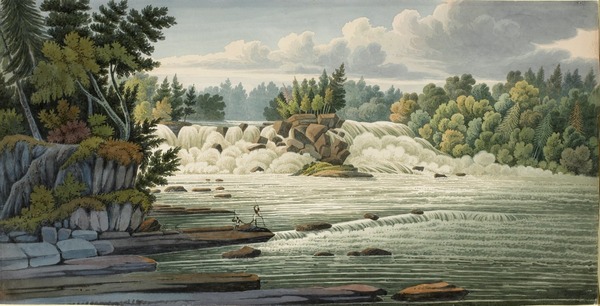 Charles Ramus Forrest Chat Falls, Lake Chaudière on the Ottawa 1822
Charles Ramus Forrest Chat Falls, Lake Chaudière on the Ottawa 1822
Source: HSO Member Margaret Back’s summary of Canadian Museum of History Archeologist (retired) Jean-Luc Pilon’s April 2017 presentation to our Society.
HSO Presents: Our Land, Our People — The Algonquins
REGISTER at http://tinyurl.com/HSO-30-Nov-2022 for our free online presentation scheduled for Wednesday, November 30th at 7pm.
The Ottawa Valley has been home to the proud Algonquin people for as many as 8,000 years. Long before the arrival of Europeans, the Algonquins lived, hunted trapped, fished, socialized and traded on both sides of the Ottawa River and along its tributaries.
Councillor Merv Sarazin, band councillor Pikwakanagan First Nation and direct descendant of the Grand Chief Constant Pinesi, explores the Algonquin people's vital connection to this history.
Here is the Zoom registration link: tinyurl.com/HSO-30-Nov-2022
Upheaval across Canada's Landscape of Commemoration
Follow this HSO presentation by Randy Boswell, Carleton University professor and journalist, as he investigates the ongoing controversy over our commemorative landscape and explores whether there are constructive healing ways forward.
Mapping the Ottawa Valley’s Ancient Indigenous Trails
HSO Presentation Wednesday, November 17, 2021
Imagine going online 500 years ago to find something on Google Maps. You’d see no grid of streets with familiar, mostly British names; no array of colourful icons directing you to coffee shops or LRT stations. What you’d have seen then is a vast wilderness broken only occasionally by a few narrow, meandering paths. These trails were winding, not because the trail makers were lost, but because the trail makers were following the path of least resistance. To the Anishinabe traders, trappers and hunters, it made more sense to go around a steep hill rather than over it. It was easier and safer to go out of your way to cross a river at its narrowest or calmest point.
The Indigenous trails that criss-crossed the Gatineau and Ottawa valleys were ignored in later centuries by civil engineers and town planners who preferred their roads to be as straight as possible, regardless of the lay of the land. As a result, the early trailways of the Ottawa area have all but vanished, but thanks to Dr. Peter Stockdale, they’re coming back to life.
Peter is continuing his research to find the routes used by the Anishinabe, to have these trails marked with informative plaques, and where possible turned back into public trails for recreational use. Peter is the founder of Kichi Sibi Trails.
In his research, Peter has confirmed that there are different types of Indigenous trails. Portage trails cross the highland between watersheds. Ritual trails were often challenging walks that lead to remote vistas were the solstice and equinox events could be watched. There are also possible “war paths” that the Anishinabe of this area may have used as much for defence as for attack. Peter is still looking into the heritage of these types of trails.
We were also fortunate to have Barb Sarazin and Merv Sarazin join in on Peter’s discussion. Barb and Marv are current councilors of the Algonquins of Pikwakanagan First Nation. Barb told a personal tale about her family and how they came to be involved in the affairs of the First Nation. Merv talked about his preferred way to get around; which is by canoe. Although land trails that Peter has been investigating were necessary to get to final destinations, the rivers and streams were the main highways for Anishinabe travelers. Merv has been making canoes since we was a child.
Find out more about the ongoing work that Peter and his team at Kichi Sibi Trails have undertaken at the Kichi Sibi Trails Facebook page.
Check out the HSO YouTube channel for a video of the full presentation.



